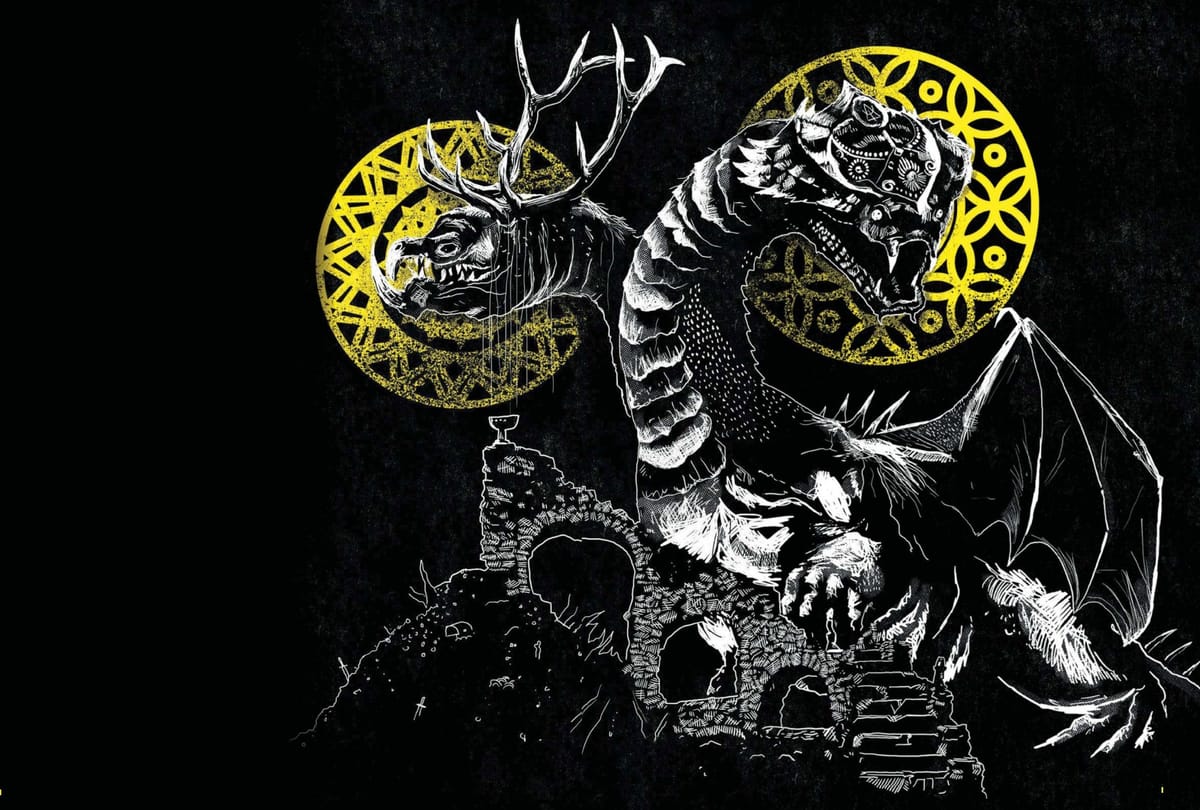
Mork Borg receives the highest recommendation of any game I have ever reviewed. It is more than a dark fantasy low magic horror roleplaying game, but as a game it delivers in spades, rusty and covered in filth though those spades may be. Mork Borg is a new landmark in how to write, present, sell, and think about an RPG, and it stands tall in a crowded market, despite its diminutive 96 page-count. While other games may have more depth or setting material, none of them communicate so well with their audience what experience is intended and how the reader is meant to get there.
While the mechanical substance of Mork Borg is quite good, the primary genius of Mork Borg comes in its presentation. Layout in RPGs is usually an esoteric slog that forces you to parse out the useful rules information from the fluff text, and only once you read the book multiple times and make your own rules references do you feel you have a handle on the game. Playing games of any satisfying complexity usually requires wading through a miasma of bad indices and page flips; not so with Mork Borg. Morg Borg is direct, in every way. Its bleak horror aesthetic bleeds through with all the splattered paint and severed heads. A few two-page spreads and you will comprehend the setting, its major conflicts, and the power structures that define it. A few more and you know the rules. The back of the book is, apart from a few numbers on your character sheet and the few sentences that are your abilities, everything you need to practically play the game. Characters are a few stats, so are monsters, and that’s about it. It’s immediate. It’s effective. It’s terrifying. And I’m in love with it.
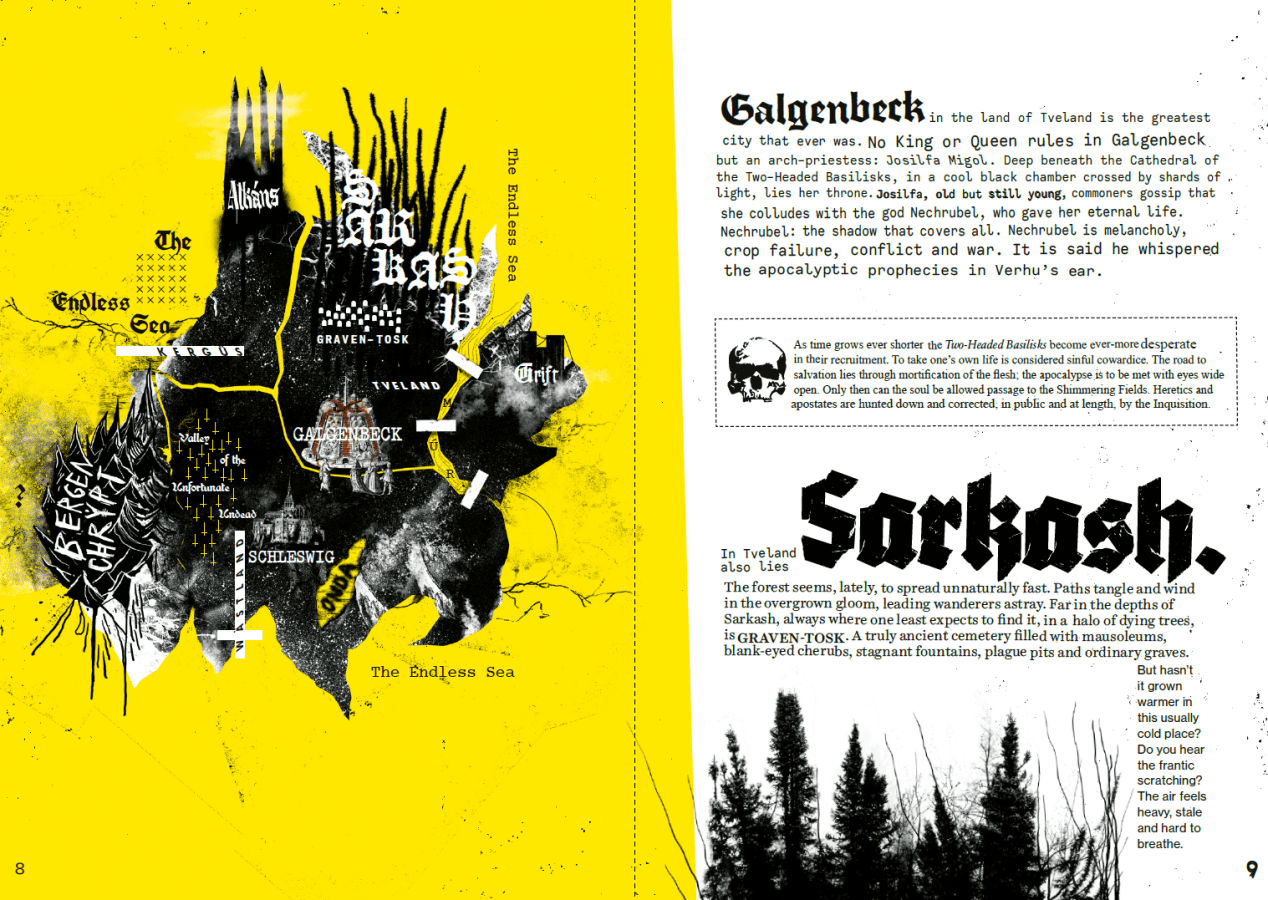
The premise of Mork Borg harkens back to the finest of Dying Earth roots that set themselves deep into the core of D&D long before its vision of fantasy shifted from Sword and Sorcery to fantasy superheroes. Not only in the world of Mork Borg but in the game itself, the world is actively coming to an end. All signs point to the world, and the game, ending with mechanical imminence. You see, a series of prophecies that have consistently proven true suggests that the apocalypse is imminent. Your table sets the likelihood, denoted by the size of die you roll once each in-game day. On a 1 of that die (you can choose from up to d100 and down to d2) triggers one of the final prophecies to come true, pushing you towards the end of all things. You can also choose to break up the prophecies into component bits or include portions randomly. This means you can run on a d2 but have more prophecies, tailoring your game to be exactly as long or as short as you decide.
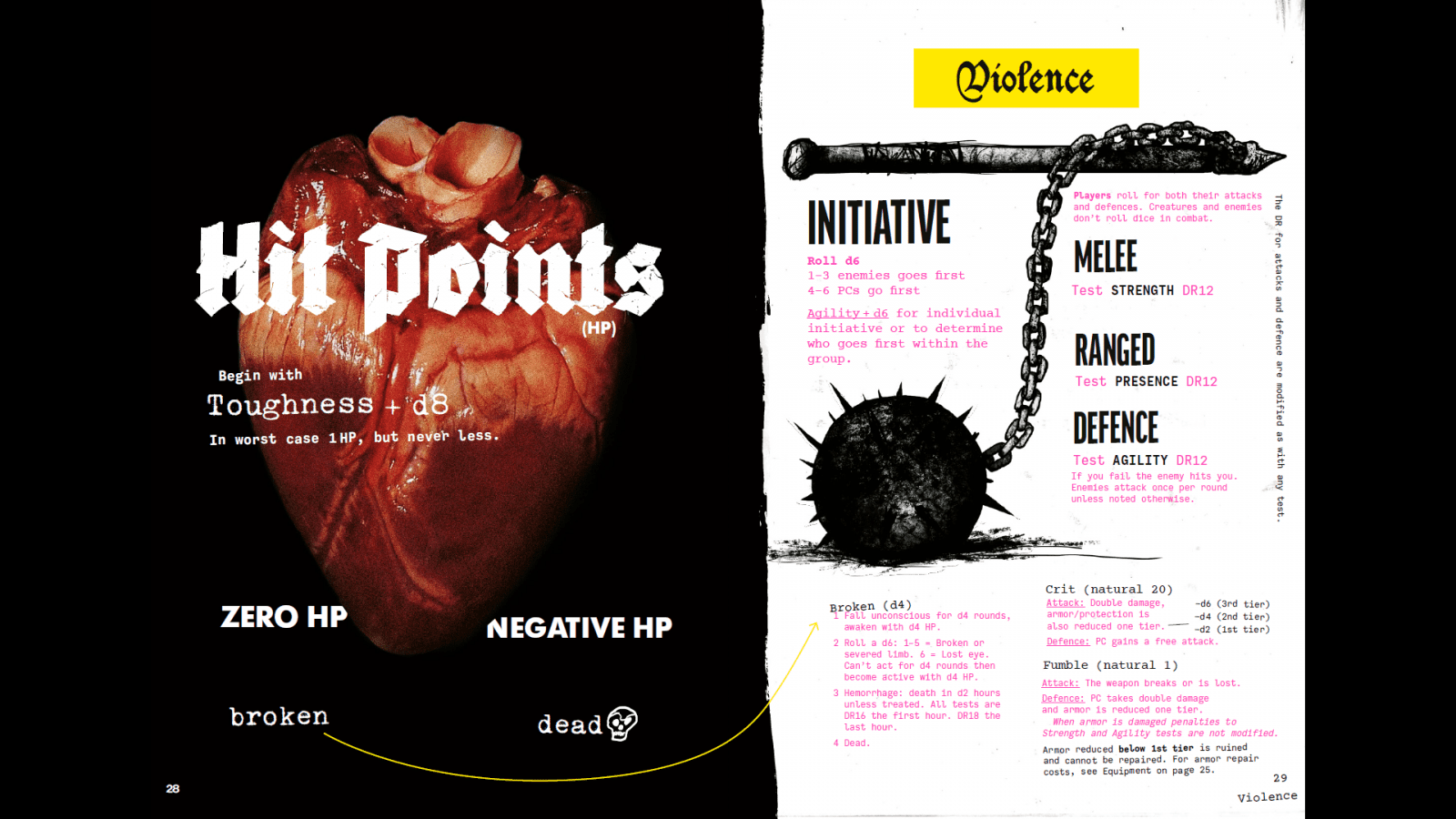
In this dark metal world, hope is nearly lost. But not completely. A brutal, metal-inspired fantasy land has seen its gods die. Its sun had not been seen for years. Vile basilisks that preach the end times are the taking over the world, and all signs point to the end. It feels exactly like 2020, and just like our current world, Dark Souls, and the Night Land, it’s a challenge to go on. To survive this cold and blasted hellscape, and make something of yourself before the end comes. My current Mork Borg campaign consists of a disgraced noble who will never see his kingdom again, a once child soldier with trauma so deep they remember little else, and the prophet to a noble god whose word was silenced with his patron’s death. They are starving, dying, hunted, and friendless. But they believe they can save the world.
Atmosphere is paramount in this game, which keeps the power levels low and the paranoia high. A single HP of damage can leave a huge impact, and every piece of equipment can be crucial. You will find yourself counting rations and moving carefully as you and your party use every bit of your wits to survive.
Mechanically, Mork Borg doesn’t have much going on, at least at first. Characters consist of four attributes, rolled randomly, some equipment and special abilities granted by your class, if you choose to have one. You will. The book frames this as an optional rule and allows you to roll 4d6 drop lowest rather than 3d6 if you go without a class, but the classes add so much variety and utility to a character that I can’t imagine anyone neglecting this option. Enemy stats consist of morale, damage, HP, and potentially some special abilities. Armor acts as damage resistance but can impose a penalty to Agility and defense. Players make all rolls except damage against themselves (defense being a reflexive action) and if you want, that’s where it stops. Usually, I dock a game for lacking mechanical depth, but Mork Borg escapes this not only because of the perfection of its rules to their purpose but because of the game’s intense modularity. The game does provide optional rules to tailor your experience to your preference, and each addition is as simple and logical as the game’s core features. With a few sentences of text, you can add new layers to your game that carry intense mechanical weight.
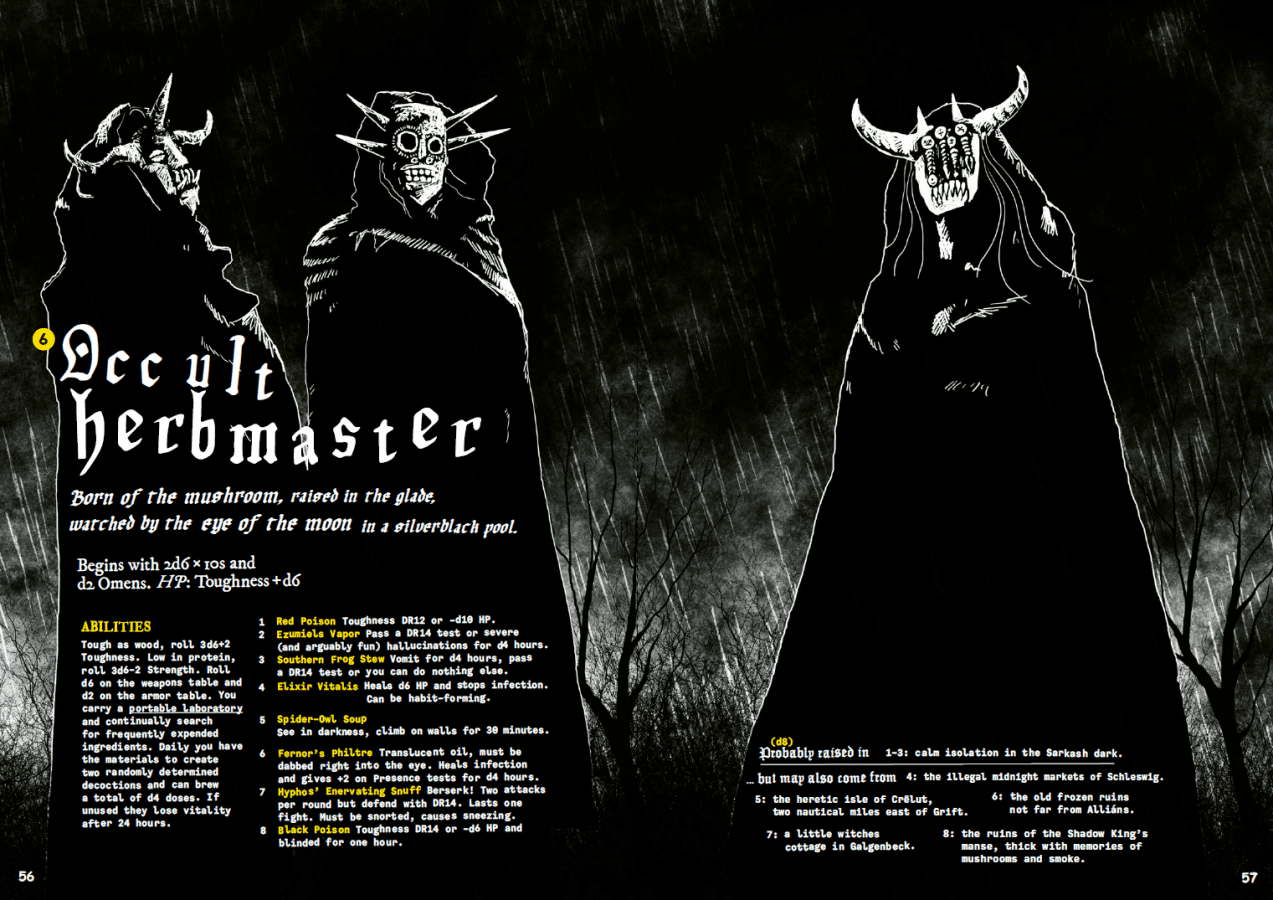
That’s not to say the game is perfect. Mork Borg is far more than your average retro-clone, but its focus on dungeons does feel limiting at times. The game does away with many meaningless hindrances of its peers, such as how it ditches attribute scores and opts directly for bonuses, but much of its consideration seems rooted in searching through dungeons for treasure. Many other adventure types would be appropriate for Mork Borg’s setting, but the mechanics so far only cover combat and exploration.
Level ups carry some mechanical weight but can make your character strictly worse (though this is very unlikely to happen). If your characters do manage to survive for an extended period, you will find them changing very little over time, at least from those level-ups. In all fairness, equipment and spells (obtained in the form of scrolls or tablets) can give you permanent new abilities, so it’s not that your character doesn’t get new skills over time. Going by the core book, you will also see all of the content fairly quickly, and leave yourself wanting more in terms of monsters, equipment, spells, and character options.
Luckily, the Mork Borg site contains free content, including a character generator, dungeons, and more. They also have excellent community support, directly licensing user-generated content. You also have to keep in mind how easy it is to create material for a game this simplistic. If you want to make an antagonist for D&D, you have to contend with numerous stats, abilities, and supplements to sort through, where Mork Borg asks only for a few numbers. Even so, maybe you will still think Mork Borg’s slim volume a little lacking. For that, we turn to the Feretory.
Mork Borg Cult: Feretory
The only substantive issue I can find with Mork Borg, its limited content, is solved by the Feretory. This tome, composed of community-generated material, contains a monster generator, new classes, rules for extended travel, new monsters, rules for hunting and foraging, new adventures, new items, a gambling mini-game, new spells, and more. Just as with the main book, everything is delivered in the same stark yet legible manner.
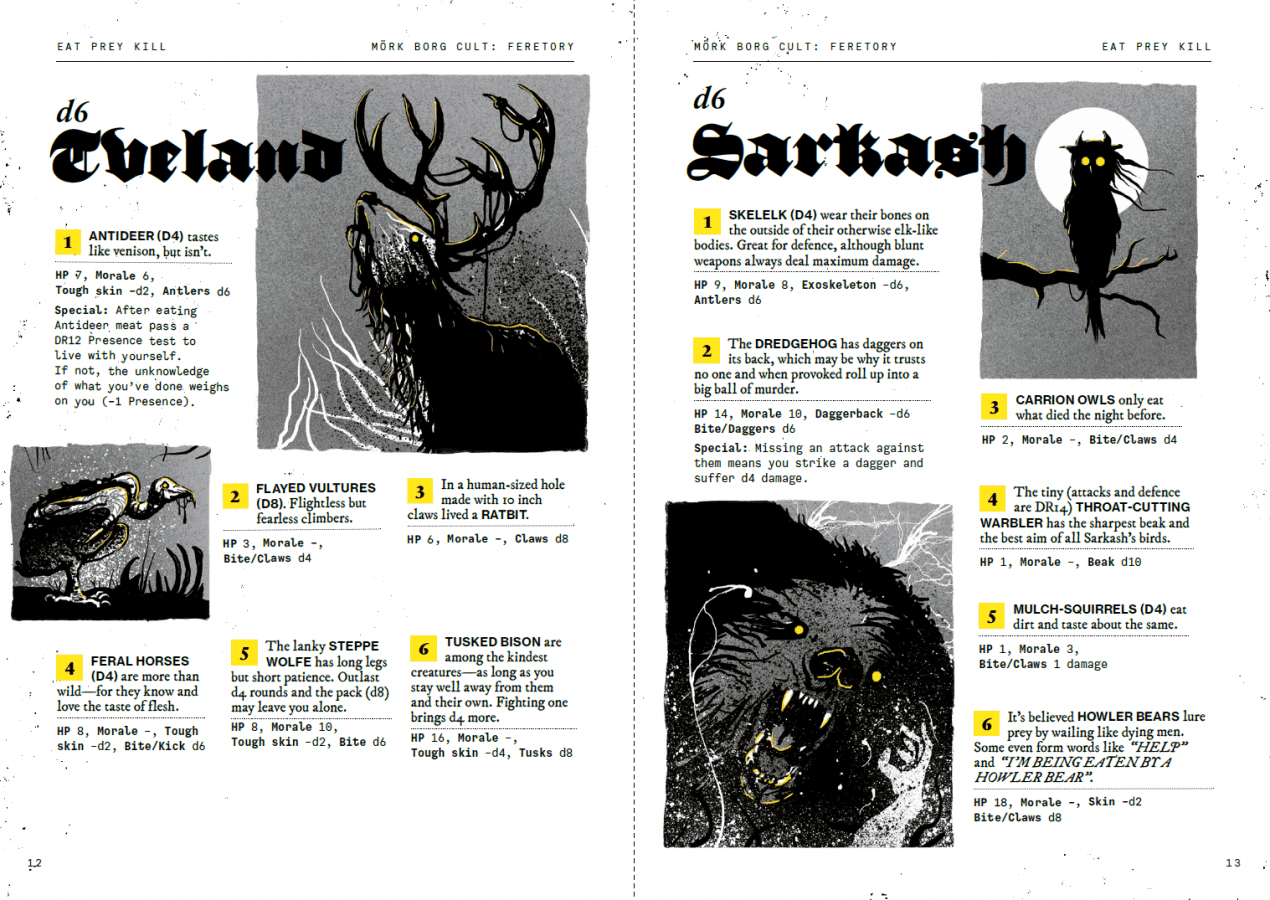
Like everything else about Mork Borg, the adventures carry through the best traditions of pulp literature: while they may be small, they communicate a ton and are easy to understand. Curse of Strahd might be a great adventure, but its writing and the layout of Castle Ravenloft are insultingly obtuse. Not so with Mork Borg’s adventures. The Death Ziggurat delivers players with an infested hex crawl, while the Goblin Grinder provides some urban investigation. Between those adventures, the one in the core book, and free material on the site, you will have more than enough material to keep your players terrified and wounded for many moons.
I consider the Feretory a necessary purchase along with Mork Borg, but the core book’s pdf is $12 at the time of writing, and the Feretory’s is $10. The physical copies are more expensive due to shipping and the lavish art, but for their sheer usability, this increase is a trifle.
As a disclaimer, I have backed The Putrescence Regnant Kickstarter (a vinyl metal album/adventure module in one) and consider myself very likely to back Mork Borg products in the future. They have earned my time, my attention, my money, and my respect. I think they deserve yours too. Mork Borg is terrifying, it’s beautiful, and I’m in love with it. Get it.
Mork Borg
Phenominal
Mork Borg has permanently raised the bar for RPG products. It communicates everything about its rules and setting in a few simple words, yet sets the mind alight with possibility. If you want to keep the light of hope in a brutal, lethal world and make the game your own, look no further than Mork Borg.
Pros
- Accessible, immediate gaming
- Excellent community resources and support
- A revolution in how RPGs are written and presented
Cons
- Level ups lack some satisfaction
- The core book contains limited content
- Dungeoneering is a limited focus
